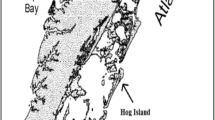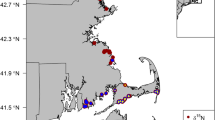Abstract
We studied organic matter cycling in two Gulf Coast tidal, nonsaline marsh sites where subsidence causes marine intrusion and rapid submergence, which mimics increased sea-level rise. The sites experienced equally rapid submergence but different degrees of marine intrusion. Vegetation was hummocked and much of the marsh lacked rooted vegetation. Aboveground standing crop and production, as measured by sequential harvesting, were low relative to other Gulf CoastSpartina patens marshes. Soil bulk density was lower than reported for healthyS. alterniflora growth but that may be unimportant at the current, moderate sulfate levels. Belowground production, as measured by sequential harvesting, was extremely fast within hummocks, but much of the marsh received little or no belowground inputs. Aboveground production was slower at the more saline site (681 g m−2 yr−1) than at the less saline site (1,252 g m−2 yr−1). Belowground production over the entire marsh surface averaged 1,401 g m−2 yr−1 at the less saline site and 585 g m−2 yr−1 at the more saline site. Respiration, as measured by CO2 emissions in the field and corrected for CH4 emissions, was slower at the less saline site (956 g m−2 yr−1) than at the more saline site (1,438 g m−2 yr−1), reflecting greater contributions byS. alterniflora at the more saline site which is known to decompose more rapidly thanS. patens. Burial of organic matter was faster at the less saline site (796 g m−2 yr−1) than at the more saline site (434 g m−2, yr−1), likely in response to faster production and slower decomposition at the less saline site. Thus vertical accretion was faster at the less saline site (1.3 cm yr−1) than at the more saline site (0.85 cm yr−1); slower vertical accretion increased flooding at the more saline site. More organic matter was available for export at the less saline site (1,377 g m−2 yr−1) than at the more saline site (98 g m−2 yr−1). These data indicated that organic matter production decreased and burial increased in response to greenhouse-like conditions brought on by subsidence. *** DIRECT SUPPORT *** A01BY069 00016
Similar content being viewed by others
Literature Cited
Bertness, M. D. 1991. Zonation ofSpartina patens andSpartina alterniflora in a New England salt marsh.Ecology 72:138–148.
Boesch, D. F., M. N. Josselyn, A. J. Mehta, J. T. Morris, W. K. Nuttle, C. A. Simenstad, and D. J. P. Swift. 1994. Scientific assessment of coastal wetland loss, restoration and management in Louisiana.Journal of Coastal Research Special Issue No. 20.
Bricker-Urso, S., S. W. Nixon, J. K. Cochran, D. J. Hirschberg, andC. Hunt. 1989. Accretion rates and sediment accumulation in Rhode Island salt marshes.Estuaries 12:300–317.
Broome, S. W., W. W. Woodhouse, Jr., andE. S. Seneca. 1975. The relationship of mineral nutrients to growth ofSpartina alterniflora in North Carolina: I. Nutrient Status of plants and soils in natural stands.Soil Science Society of America Proceedings 39:295–301.
Chabreck, R. H. 1970. Marsh zones and vegetative types of the Louisiana coastal marshes. Ph.D. Dissertation. Louisiana State University. Baton Rouge Louisiana.
Chabreck, R. H. andG. Linscombe. 1978. Vegetative Type Map of the Louisiana Coastal Marshes. Louisiana Department of Wildlife and Fisheries, Baton Rouge, Louisiana.
Chabreck, R. H. andR. G. Linscombe. 1988. Change in vegetative types in Louisiana coastal marshes over a 10-year period.Louisiana Academy of Sciences 1982:98–102.
Chabreck, R. H. and R. G. Linscombe. 1988. Louisiana Department of Wildlife and Fisheries. Baton Rouge, Louisiana.
Chalmers, A. G. 1982. Soil dynamics and the productivity ofSpartina alterniflora, p. 231–242.In V. S. Kennedy (ed.), Estuarine Comparisons. Academic Press, New York.
Coleman, J. M. 1988., Dynamic changes and processes in the Mississippi River delta.Geological Society of America Bulletin 100: 999–1015.
Coleman, J. M. andS. M. Gagliano. 1964. Cyclic sedimentation in the Mississippi River Deltaic Plain.Transactions of the Gulf Coast Association of Geological Societies 1964:67–80.
Craft, C. B., S. W. Broome, andE. D. Seneca. 1989. Exchange of nitrogen, phosphorus, and organic carbon between transplanted marshes and estuarine waters.Journal of Environmental Quality 18:206–211.
Craft, C. B., E. D. Seneca, andS. W. Broome. 1993. Vertical accretion in microtidal regularly and irregularly flooded estuarine marshes.Estuarine Coastal and Shelf Science 37:371–386.
Daiber, F. C. 1986. Conservation of Tidal Marshes. Van Nostrand Reinhold Co., New York.
Davies, B. E. 1974. Loss-on-ignition as an estimate of soil organic matter.Soil Science Society of America Proceedings 38:150–151.
Day, J. W. Jr.,W. G. Smith, P. R. Wagner, andW. C. Stowe. 1973. Community structure and carbon budget of salt marsh and shallow bay estuarine system in Louisiana. Sea Grant Publication LSU-SG-72-04. Center for Wetland Resources, Louisiana State University. Baton Rouge, Louisiana.
De la Cruz, A. A. andC. T. Hackney. 1977. Energy value, elemental composition, and productivity of belowground biomass of aJuncus tidal marsh.Ecology 58:1165–1170.
DeLaune, R. D. andS. R. Pezeshki. 1988. Relationship of mineral nutrients to growth ofSpartina alterniflora in Louisiana salt marshes.Northeast Gulf Science 10:55–60.
DeLaune, R. D., W. H. Patrick, Jr., andN. Van Breemen. 1990. Processes governing marsh formation in a rapidly subsiding coastal environment.Catena 17:277–288.
DeLaune, R. D., W. H. Patrick, Jr., andR. J. Buresh. 1978. Sedimentation rates determined by 137Cs dating in a rapidly accreting salt marsh.Nature 275:532–533.
DeLaune, R. D., C. N. Reddy, andW. H. Patrick, Jr. 1981. Accumulation of plant nutrients and heavy metals through sedimentation processes and accretion in a Louisiana salt marsh.Estuaries 4:328–334.
DeLaune, R. D. andC. J. Smith. 1984. The carbon cycle and the rate of vertical accumulation of peat in the Mississippi River Deltaic Plain.Southeastern Geology 25:61–69.
DeLaune, R. D., C. J. Smith, andW. H. Patrick, Jr. 1983. Relationship of marsh elevation, redox potential, and sulfide toSpartina alterniflora productivity.Soil Science Society of America Journal 47:930–935.
Faulkner, S. P., W. H. Patrick, Jr., andR. P. Gambrell. 1989. Field techniques measuring wetland soil parameters.Soil Science Society of American Journal 53:883–890.
Feijtel, T. C., R. D. DeLaune, andW. H. Patrick, Jr. 1985. Carbon flow in coastal Louisiana.Marine Ecology Progress Series 24:255–260.
Frazier, D. E. 1967. Recent deltaic deposits of the Mississippi River: Their development and chronology.Transactions of the Gulf Coast Association of Geological Societies 1967:287–311.
Gallagher, J. L. andF. G. Plumley. 1979. Underground biomass profiles and productivity in Atlantic coastal marshes.American Journal of Botany 66:156–161.
Good, R. E., N. F. Good, andB. R. Frasco. 1982. A review of primary production and decomposition dynamics of the belowground marsh component, p. 139–157.In V. S. Kennedy (ed.). Estuarine Comparisons. Academic Press, New York.
Hatton, R. S., R. D. DeLaune, andW. H. Patrick, Jr. 1983. Sedimentation, accretion, and subsidence in marshes of Barataria Basin, Louisiana.Limnology and Oceanography 28:494–502.
Hook, D. D. 1984. Adaptations to flooding with fresh water, p. 265–294.In T. T. Kozlowski (ed.), Flooding and Plant Growth. Academic Press, New York.
Hopkinson, Jr.,C. S. andE. L. Dunn. 1984. Rapid sampling of organic matter in flooded soils and sediments.Estuaries, 7:181–184.
Hopkinson, C. S., J. G. Gosselink, andR. T. Parrondo. 1978. Above-ground production of seven marsh plant species in coastal Louisiana.Ecology 59:760–769.
Hopkinson, C. S., J. G. Gosselink, andR. T. Parrondo. 1980. Production of coastal Louisiana marsh plants calculated from phenometric techniques.Ecology 61:1091–1098.
Jackson, M. B. 1985. Ethylene and responses of plants to soil waterlogging and submergence.Annual Review of Plant Physiology 36:145–174
Jordan, T. E., D. F. Whigham, andD. L. Correll. 1989. The role of litter in nutrient cycling in a brackish tidal marsh.Ecology 70:1906–1915.
King, G. M., M. J. Klug, R. G. Weigert, andA. G. Chalmers. 1982. Relation of soil water movement and sulfide concentration toSpartina alterniflora production in a Georgia salt marsh.Science 218:61–63.
Knox, G. A., 1986. Estuarine ecosystems: A systems approach. Volume I. CRC Press, Boca Raton, Florida.
Kozlowski, T. T. andS. G. Pallardy. 1984. Effects of flooding on water, carbohydrate, and mineral relations, p. 165–193.In T. T. Kozlowski (ed.), Flooding and Plant Growth. Academic Press, New York
McCaffrey, R. J. andJ. Thomson. 1980. A record of the accumulation of sediment and trace metals in a Connecticut salt marsh.Advances in Geophysics 22:165–236.
Morgan, J. P. 1967. Ephemeral estuaries of the deltaic environment, p. 115–120.In G. H. Lauff (ed.), Estuaries. American Association for the Advancement of Science. Washington D.C.
Mitsch, W. J. andJ. G. Gosselink. 1984. Wetlands. Van Nostrand Reinhold Co., New York.
Naidoo, G., K. L. McKee, andI. A. Mendelssohn. 1992. Anatomical and metabolic responses to waterlogging and salinity inSpartina alterniflora andS. patens (Poaceae).American Journal of Botany 79:765–770.
Newton, M. B., Jr. 1972. Atlas of Louisiana-A guide for students. Geoscience Publications. Loisiana State University, Baton Rouge, Louisiana.
Nyman, J. A., M. Carloss, R. D. DeLaune, andW. H. Patrick, Jr. 1993b. Are landscape patterns related to marsh loss processes? p. 337–348.In Coastal Zone ′98, Proceedings, 8th Symposium on Coastal and Ocean Management. American Society of Civil Engineers, New York.
Nyman, J. A., M. Carloss, R. D. DeLaune, andW. H. Patrick, Jr. 1994. Erosion rather than plant dieback as the mechanism of marsh loss in an estuarine marsh.Earth Surface Proneses and Landforms 19:69–84.
Nyman, J. A. andR. D. DeLaune. 1991. CO2 emission and soil Eh responses to different hydrological conditions in fresh, brackish, and saline marsh soils.Limnology and Oceanography 36:1406–1414.
Nyman, J. A., R. D. DeLaune, H. H. Roberts, andW. H. Patrick, Jr. 1993a. Relationship between vegetation and soil formation in a rapidly submerging coastal marsh.Marine Ecology Progress Series 96:269–279.
O'Neil, T. 1949. The muskrat in the Louisiana coastal marshes. Federal Aid Section-Fish and Game Division, Louisiana Department of Wild Life and Fisheries, New Orleans, Louisiana.
Penland, S. andK. E. Ramsey. 1990. Relative sea-leav rise in Louisiana and the Gulf of Mexico: 1908–1988.Journal of Coastal Research 6:323–342.
Penland, S., K. E. Ramsey, R. A. McBride, J. D. Mestayer, andK.A. Westphal. 1988. Relative sea level rise and delta-plain development in the Terrebonne Parish Region. Coastal Geology Technical Report No. 4. Louisiana Geological Survey, Baton Rouge, Louisiana.
Pezeshki, S. R. andR. D. DeLaune. 1991. A comparative study of above-ground productivity of dominant U.S. Gulf Coast marsh species.Journal of Vegetation Science 2:331–338.
Reed, D. J. 1989. Patterns of sediment deposition in subsiding coastal salt marshes, Terrebonne, Bay, Louisiana: The role of winter storms.Estuaries 12:222–227.
Sasser, C. E. 1977. Distribution of vegetation in Louisiana coastal marshes as response to tidal flooding. M.S. Thesis. Louisiana State Universty. Baton Rouge, Louisiana.
Schubauer, J. P. andC. S. Hopkinson. 1984. Above- and belowground emergent macrophyte production and turnover in a coastal marsh ecosystem, Georgia.Limnology and Oceanography 29:1052–1065.
Shrew, D. M., R. A. Linthurst, andE. D. Seneca. 1981. Comparison of production methods in a southeastern North, CarolinaSpartina alterniflora salt marsh.Estuaries 4:97–109.
Smith, C. J., R. D. Delaune, andW. H. Patrick, Jr. 1983. Carbon dioxide emission and carbon accumulation in coastal wetlands.Estuarine, Coastal and Shelf Science 17:21–29.
Steele, R. G. D. andJ. H. Torrie. 1980. Principles and Procedures of Statistics. A Biometrical Approach. Second Edition. McGraw-Hill, Inc. New York.
Stumpf, R. P. 1983. The process of sedimentation on the surface of a salt marsh.Estuarine, Coastal and Shelf Science, 17:495–508.
Titus, J. G. 1986. Greenhouse effect, sea level rise, and coastal zone management.Coastal Zone Management Journal 14:147–171.
United States Department of Agriculture. 1956. Soil Survey Terrebonne Parish Louisiana. Louisiana Agricultural Experiment Station, Soil Conservation Service, United States Department of Agriculture. Washington, D.C.
Valiela, I., J. M. Teal, andN. Y. Persson. 1976. Production and dynamics of experimentally enriched salt marsh vegetation: Belowground biomass.Limnology and Oceanography 21: 245–252.
Wang, F. C., T. Lu, andW. B. Sikora. 1993. Intertidal marsh suspended sediment transport processes, Terrebonne Bay, Louisiana, U.S.A.Journal of Coastal Research 9:209–220.
White, D. A., T. E. Weiss, J. M. Trapani, andL. B. Thien. 1978. Productivity and decomposition of the dominant salt marsh plants in Louisiana.Ecology 59:751–759.
Wilson, B. D. andW. V. Staker. 1932. Relation of organic matter to organic carbon in the peat soils of New York.Journal of the American Society of Agronomy 24:477–481.
Author information
Authors and Affiliations
Rights and permissions
About this article
Cite this article
Nyman, J.A., DeLaune, R.D., Pezeshki, S.R. et al. Organic matter fluxes and marsh stability in a rapidly submerging estuarine marsh. Estuaries 18, 207–218 (1995). https://doi.org/10.2307/1352631
Received:
Accepted:
Issue Date:
DOI: https://doi.org/10.2307/1352631




